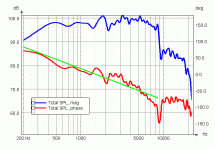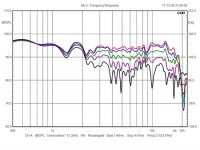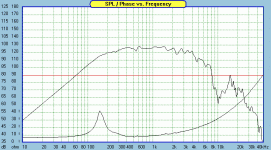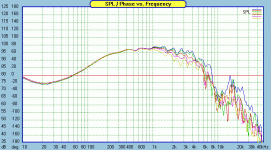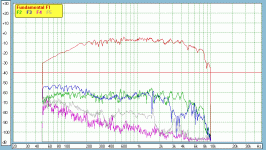Well, so turns out that the there are practically no choice and no alternative Supravox?
The Supravox still isn't a good choice. 😉
(..and this is coming from someone who is rather fond of Supravox.) 😱
This graph is a lot more honest, and even it doesn't show the problems with the surround at 1.4 kHz:
(..note that the coated (nextel) version of this driver will help smooth out the upper band ripple, part #PR170N0).
Well, well, honest. Ask about it Rainer of Proraum Vertriebs-GmbH | Startseite
He said that what measurements were made as follows: "There are so many idiots around and that was done in 1993... young
engineers from university, NO practical knowledge 🙂
And due to the wrong parameters of course.
What I measure here is perfect! We control regularly."
Last edited:
..well, at least the 25*21* is far more linear.
How do we know that ?
There is no distortion plots of Supravox to be found in this internet. I have searched, more than many times.
How do we know that ?
There is no distortion plots of Supravox to be found in this internet. I have searched, more than many times.
Supravox DTQWTSupravox 215RFT-
The Supravox still isn't a good choice. 😉
(..and this is coming from someone who is rather fond of Supravox.) 😱
Why? Just because quality of manufacturing is unstable?
Well, well, honest. Ask about it Rainer of Proraum Vertriebs-GmbH | Startseite
He said that what measurements were made as follows: "There are so many idiots around and that was done in 1993... young
engineers from university, NO practical knowledge 🙂
And due to the wrong parameters of course.
What I measure here is perfect! We control regularly."
Accept what you posted wasn't there measurements. 😉
It was *also* Audax's.
Why? Just because quality of manufacturing is unstable?
No.
Look at Troel's measurements.
Particularly look at 1.4 kHz, and 2.2 kHz.
Also look at its non-linear distortion.
Finally, look to the off-axis performance in relation to something like the PHL mid that Zaph measured.
Here (Supravox RTF 64):
(..note that off-axis and distortion measurements here include the cone tweeter, and are still poor by comparison. Off-axis on the 3rd graph only represents 0,10,20,30,& 40 degrees.)
(..note that off-axis and distortion measurements here include the cone tweeter, and are still poor by comparison. Off-axis on the 3rd graph only represents 0,10,20,30,& 40 degrees.)
Attachments
Last edited:
Vs. (PHL):
(Off-axis extends to 0, 15, 30, 45, & 60 degrees.)
(Off-axis extends to 0, 15, 30, 45, & 60 degrees.)
Attachments
Last edited:
I have seen this article before, and even today it is viewed. Now read again and did not see much wrong. "You may think the bump at 1800 Hz is really bad. It isn't. Nothing severe is going on here in terms of sudden major large phase shifts and from even mild equalisation as can be seen below, it even starts looking good on paper . This, by the way, tells how bad frequency response graphs are in terms of telling how a speaker actually sounds. The phase graph may actually be more interesting. "
I have seen this article before, and even today it is viewed. Now read again and did not see much wrong. "You may think the bump at 1800 Hz is really bad. It isn't. Nothing severe is going on here in terms of sudden major large phase shifts and from even mild equalisation as can be seen below, it even starts looking good on paper . This, by the way, tells how bad frequency response graphs are in terms of telling how a speaker actually sounds. The phase graph may actually be more interesting. "
With respect to that, look at it in relation to the PHL unit (..where we actually have an absolute comparison).
Even the PHL has a -4 db at 2.2 kHz.. but the overall average is substantially better.
As for non-linear distortion it's not even close, the PHL "walks all over" the Supravox.
Finally there is the issue of off-axis performance above 2 kHz. I don't know of a large high eff. mid that is better than the PHL's that extends usefully higher in freq..
So, and what to do? The PHL - no good. The supravox - no good too. What else? Audax?
AER? Voxative?
AER? Voxative?
So, and what to do?
Actually I think the PHL would work.
IF you limit the bandwidth some (both top and bottom), you'll have an much greater selection.
..perhaps a 4 driver line of these:
The Madisound Speaker Store
These have almost the surface area of an 8" driver (in a group of 4), but much better off-axis performance (assuming a vertical line). Perhaps 400 Hz to 3-4 kHz? Average eff. should be about 96-97 db.
Last edited:
No! The main goal - the range from 200 Hz to 5 kHz to sound from one speaker!
Then no matter what you do, it's going to be EXTREMELY difficult to get a good crossover transition to that driver at the top of its range.
Basically your design premise has some problems. 😉
(..try going back and read the entire design process on the Supravox by Troels.)
BTW, you could extend any of these drivers to 200 Hz.. you just won't get a lot of spl out of them (and you will get more distortion as a result). On the other hand the PHL starts off with lower distortion, so as long as you have a good high-pass crossover for it then you'd still be OK.
may be two serial Supravox 165LB?
Diameter is MUCH to large, combing starts much lower in freq..
These have almost the surface area of an 8" driver (in a group of 4), but much better off-axis performance (assuming a vertical line). Perhaps 400 Hz to 3-4 kHz? Average eff. should be about 96-97 db.
It will be a very high speaker!))) Low-frequency section has a height of about 1 meter if there will be 4 X 110 plus the distance between + 170 Beyma, only get about 2 meters height!))
Mesures 165 LB SUPRAVOX - page 1Diameter is MUCH to large, combing starts much lower in freq..
An externally hosted image should be here but it was not working when we last tested it.
An externally hosted image should be here but it was not working when we last tested it.
An externally hosted image should be here but it was not working when we last tested it.
may be two serial Supravox 165LB?
The problem is using two of them on one speaker ..unless you are using them with different low-pass crossovers. (..that was the combing problem I was referring to.)
At that point though, you should probably be looking at two different drivers that each do their part better. (..particularly a smaller driver for the higher freq.s for better off-axis performance.)
- Status
- Not open for further replies.
- Home
- Loudspeakers
- Multi-Way
- Supravox 215 vs PHL 2540
